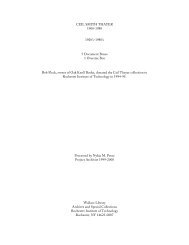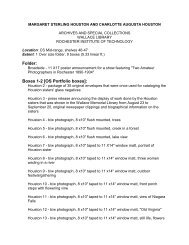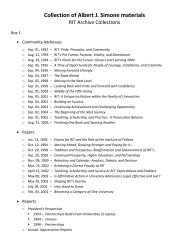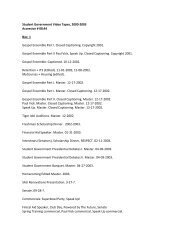What is Deafhood collection
What is Deafhood collection
What is Deafhood collection
Create successful ePaper yourself
Turn your PDF publications into a flip-book with our unique Google optimized e-Paper software.
<strong>Deafhood</strong>: Your Journey<br />
David Eberwein, Genie Gertz &<br />
Ella Mae Lentz<br />
Rochester, New York<br />
March 29, 2008
<strong>Deafhood</strong> Concept<br />
Paddy Ladd<br />
University of Br<strong>is</strong>tol<br />
United Kingdom<br />
© 2008, Eberwein, Gertz & Lentz
Message from Paddy Ladd<br />
© 2008, Eberwein, Gertz & Lentz
Our <strong>Deafhood</strong><br />
Journey<br />
© 2008, Eberwein, Gertz & Lentz
Museum of<br />
deafness<br />
© 2008, Eberwein, Gertz & Lentz
Reflection<br />
Define the sign „DEAF‟<br />
(in Engl<strong>is</strong>h: the generic word „deaf‟)<br />
(without reference to „hearing‟)<br />
© 2008, Eberwein, Gertz & Lentz
“…today‟s problems cannot be<br />
solved without a sound<br />
understanding of the past.”<br />
Tage Erlander<br />
Sweden‟s former Prime Min<strong>is</strong>ter<br />
© 2008, Eberwein, Gertz & Lentz
The Deaf World<br />
Before 1880<br />
© 2008, Eberwein, Gertz & Lentz
The Par<strong>is</strong> Deaf School<br />
• Establ<strong>is</strong>hed by l‟Epee in 1700‟s<br />
• Birthplace of academic and formal Deaf<br />
and Sign Language community<br />
• Results<br />
© 2008, Eberwein, Gertz & Lentz
© 2008, Eberwein, Gertz & Lentz
The Par<strong>is</strong> Banquets<br />
• Deaf speeches aimed to<br />
illustrate the highest levels<br />
of Deaf philosophies<br />
• Influential hearing persons<br />
invited<br />
• Most speeches translated<br />
to French and printed<br />
© 2008, Eberwein, Gertz & Lentz<br />
Ferdinand Berthier<br />
Ladd P. (2003). Understanding Deaf Culture: In Search of <strong>Deafhood</strong>. Clevedon, England: Multilingual Matters Ltd.
Excerpts from the Records<br />
“[Sign Language] easily wins out<br />
over all the separate limiting<br />
languages of speaking humanity…<br />
Our language encompasses all<br />
nations, the entire globe.”<br />
Ladd P. (2003). Understanding Deaf Culture: In Search of <strong>Deafhood</strong>. Clevedon, England: Multilingual Matters Ltd.<br />
© 2008, Eberwein, Gertz & Lentz
Pre-Milan D<strong>is</strong>course<br />
…an “incomplete” man according to these<br />
[Deaf] gentlemen, a “wretch” deprived of the<br />
language of mimicry…having to resort to a<br />
pencil to converse with the evening‟s heroes.<br />
An expression of ineffable pity could be read<br />
on their faces at h<strong>is</strong> approach.<br />
© 2008, Eberwein, Gertz & Lentz<br />
-Mottez
Tenets of Par<strong>is</strong> Banquets‟<br />
D<strong>is</strong>course<br />
• Deaf people were highly literate in Engl<strong>is</strong>h<br />
and other languages<br />
• Sign Languages cross international<br />
boundaries<br />
• Signing <strong>is</strong> a gift to hearing people<br />
• Deaf‟s ex<strong>is</strong>tence should not be called into<br />
question<br />
• Deaf people have the potential to become<br />
the world‟s first truly global citizens<br />
© 2008, Eberwein, Gertz & Lentz
By the 1870s, Deaf people…<br />
• establ<strong>is</strong>hed and admin<strong>is</strong>tered schools<br />
• edited hearing newspapers<br />
• were art<strong>is</strong>ts and publ<strong>is</strong>hers<br />
© 2008, Eberwein, Gertz & Lentz
Gallaudet University<br />
• Establ<strong>is</strong>hed in 1864<br />
• Result of Par<strong>is</strong> school and Clerc‟s training<br />
• Deaf people were highly literate in Engl<strong>is</strong>h<br />
and other languages<br />
© 2008, Eberwein, Gertz & Lentz
BUT…<br />
© 2008, Eberwein, Gertz & Lentz
“The deaf believe that they are our<br />
equals in all respects. We should be<br />
generous and not destroy that illusion.<br />
But whatever they believe, deafness <strong>is</strong><br />
an infirmity and we should repair it<br />
whether the person who has it <strong>is</strong><br />
d<strong>is</strong>turbed by it or not.”<br />
-Propser Meniere (1855)<br />
Brueggemann, B. J. (1999). Lend Me Your Ear: Irhetorical Constructions of Deafness. Washington, DC: Gallaudet University Press.<br />
© 2008, Eberwein, Gertz & Lentz
September 1880<br />
International Congress on<br />
Education of the Deaf<br />
Milan, Italy<br />
© 2008, Eberwein, Gertz & Lentz
1880: The Milan Conference<br />
• 164 delegates in attendance<br />
• Only 1 Deaf in attendance<br />
(James Den<strong>is</strong>on- Kendall School principal)<br />
• “…the Pure Oral Method ought to be<br />
preferred”… passed with only six in<br />
opposition<br />
(James Den<strong>is</strong>on, Edward Miner Gallaudet, h<strong>is</strong> brother Thomas<br />
Gallaudet, Isaac Lew<strong>is</strong> Peet, Charles Stoddard, & Richard<br />
Elliott- a Brit<strong>is</strong>h teacher)<br />
Van Cleve, J. V. & Crouch, B. (1989). A Place of Their Own: Creating the Deaf Community in America. Washington, DC:<br />
Gallaudet University Press.<br />
© 2008, Eberwein, Gertz & Lentz
Alexander Graham Bell<br />
• Advocated oral education<br />
• Claimed to invent a telephone<br />
while trying to make a hearing<br />
aid<br />
• In 1921, honorary president of<br />
the Second International<br />
Congress of Eugenics<br />
http://www.italianh<strong>is</strong>torical.org/MeucciStory.htm<br />
http://www.esanet.it/chez_basilio/us_bell.htm<br />
© 2008, Eberwein, Gertz & Lentz
We should try ourselves to forget<br />
that they are deaf. We should try to<br />
teach them to forget that they are<br />
deaf.<br />
Alexander Graham Bell (1884)<br />
Ladd P. (2003). Understanding Deaf Culture: In Search of <strong>Deafhood</strong>. Clevedon, England: Multilingual Matters Ltd.<br />
© 2008, Eberwein, Gertz & Lentz
I admit the ease with which a deaf child<br />
acquires sign language and its perfect<br />
adaptability for the purpose of developing<br />
h<strong>is</strong> mind; but after all it <strong>is</strong> not the language<br />
of the million of people among who h<strong>is</strong> lot<br />
<strong>is</strong> cast.<br />
- Alexander Graham Bell (1884)<br />
© 2008, Eberwein, Gertz & Lentz
Colonial<strong>is</strong>m<br />
© 2008, Eberwein, Gertz & Lentz
Colonial<strong>is</strong>m<br />
The destruction and replacement of<br />
indigenous cultures by powerful<br />
cultures:<br />
• Language<br />
• Way of thinking and acting<br />
• Conception of world and society<br />
• Values<br />
Ladd P. (2003). Understanding Deaf Culture: In Search of <strong>Deafhood</strong>. Clevedon, England: Multilingual Matters Ltd.<br />
© 2008, Eberwein, Gertz & Lentz
Colonial<strong>is</strong>m of the<br />
Deaf World:<br />
1880-present<br />
© 2008, Eberwein, Gertz & Lentz
Colonial<strong>is</strong>m of the Deaf World<br />
• Teacher training programs<br />
• Science<br />
• Technology<br />
• Education<br />
• Parent d<strong>is</strong>courses<br />
• Research funds<br />
Ladd P. (2003). Understanding Deaf Culture: In Search of <strong>Deafhood</strong>. Clevedon, England: Multilingual Matters Ltd.<br />
© 2008, Eberwein, Gertz & Lentz
Colonial<strong>is</strong>m<br />
The colonial<strong>is</strong>t mind may be impervious<br />
to most forms of logic.<br />
© 2008, Eberwein, Gertz & Lentz<br />
- Paddy Ladd
Colonizing American<br />
Deaf Education<br />
• 1880- the Milan Conference<br />
• 1882- 7.5% of students taught orally<br />
• 1900- 47%<br />
• 1905- 51%<br />
• 1919- 80% (approximately)<br />
Van Cleve, J. V. & Crouch, B. (1989). A Place of Their Own: Creating the Deaf Community in America. Washington, DC:<br />
Gallaudet University Press.<br />
© 2008, Eberwein, Gertz & Lentz
The R<strong>is</strong>e of Oral<strong>is</strong>m<br />
After 1880: a sharp decline in…<br />
• Educated Deaf people<br />
• Deaf teachers & admin<strong>is</strong>trators<br />
• Deaf people with high-level occupations<br />
• Deaf people with language<br />
Van Cleve, J. V. & Crouch, B. (1989). A Place of Their Own: Creating the Deaf Community in America. Washington, DC:<br />
Gallaudet University Press.<br />
© 2008, Eberwein, Gertz & Lentz
Post-Milan D<strong>is</strong>course<br />
Since Oral<strong>is</strong>m was everywhere, Deaf<br />
d<strong>is</strong>courses were now limited to…<br />
• defending sign language<br />
• defending the Deaf ex<strong>is</strong>tence<br />
Ladd P. (2003). Understanding Deaf Culture: In Search of <strong>Deafhood</strong>. Clevedon, England: Multilingual Matters Ltd.<br />
© 2008, Eberwein, Gertz & Lentz
Reflection<br />
Env<strong>is</strong>ion a current Deaf World where<br />
128 years of Oral<strong>is</strong>m never happened<br />
© 2008, Eberwein, Gertz & Lentz
Effects of<br />
Colonial<strong>is</strong>m<br />
© 2008, Eberwein, Gertz & Lentz
Other Character<strong>is</strong>tics<br />
of Colonial<strong>is</strong>m<br />
• Systematic development<br />
• Colonizing society delegates work of<br />
running colonies to „special<strong>is</strong>ts‟<br />
In Deaf colonization, these are drawn from:<br />
• Scient<strong>is</strong>ts<br />
• Medical Professionals<br />
• Educators<br />
Ladd P. (2003). Understanding Deaf Culture: In Search of <strong>Deafhood</strong>. Clevedon, England: Multilingual Matters Ltd.<br />
© 2008, Eberwein, Gertz & Lentz
Effects of Colonial<strong>is</strong>m<br />
As a result of the fragmentation caused by<br />
colonial<strong>is</strong>m…it has created minorities<br />
within our minority group…<br />
• Differing languages and communication<br />
systems<br />
• Differing attitudes and behavior…leading to<br />
aggression and conflict towards one another.<br />
Ladd P. (2003). Understanding Deaf Culture: In Search of <strong>Deafhood</strong>. Clevedon, England: Multilingual Matters Ltd.<br />
© 2008, Eberwein, Gertz & Lentz
Effects of Colonial<strong>is</strong>m<br />
Deaf communities‟ energies are spent in<br />
two directions at once;<br />
1- external; defending gains or res<strong>is</strong>ting<br />
oppression<br />
2- internal; rebuilding and strengthening the<br />
community by making explicit its cultural<br />
beliefs<br />
Ladd P. (2003). Understanding Deaf Culture: In Search of <strong>Deafhood</strong>. Clevedon, England: Multilingual Matters Ltd.<br />
© 2008, Eberwein, Gertz & Lentz
Subs<strong>is</strong>tence Level<br />
The effect of colonial<strong>is</strong>m…reduced Deaf<br />
communities to a kind of “subs<strong>is</strong>tence<br />
level”<br />
• Sports organizations OK<br />
• Political & art<strong>is</strong>tic domains damaged<br />
• Our club, organizational experiences<br />
Ladd P. (2003). Understanding Deaf Culture: In Search of <strong>Deafhood</strong>. Clevedon, England: Multilingual Matters Ltd.<br />
© 2008, Eberwein, Gertz & Lentz
Effects of Colonial<strong>is</strong>m<br />
“When Deaf children receive such shamefully<br />
oppressive education, it <strong>is</strong> not only the individual<br />
who <strong>is</strong> damaged, but the community (as well).”<br />
“Oppression v<strong>is</strong>ited on Deaf children <strong>is</strong> in fact a<br />
double oppression.”<br />
Ladd P. (2003). Understanding Deaf Culture: In Search of <strong>Deafhood</strong>. Clevedon, England: Multilingual Matters Ltd.<br />
© 2008, Eberwein, Gertz & Lentz
Colonial<strong>is</strong>m‟s #1 Success<br />
The most important success<br />
of colonial<strong>is</strong>m <strong>is</strong> NOT “Deaf<br />
versus hearing”, but setting…<br />
Deaf against Deaf!<br />
Ladd P. (2003). Understanding Deaf Culture: In Search of <strong>Deafhood</strong>. Clevedon, England: Multilingual Matters Ltd.<br />
© 2008, Eberwein, Gertz & Lentz
Pockets of Res<strong>is</strong>tance<br />
(1880 - 1960‟s)<br />
• Gallaudet University<br />
• Associations of the Deaf<br />
• NAD‟s films (1910‟s)<br />
• Deaf clubs<br />
• “1001 Victories”<br />
• Deaf mutes (added by E. Lentz)<br />
Ladd P. (2003). Understanding Deaf Culture: In Search of <strong>Deafhood</strong>. Clevedon, England: Multilingual Matters Ltd.<br />
© 2008, Eberwein, Gertz & Lentz
Critical<br />
Examination<br />
© 2008, Eberwein, Gertz & Lentz
Critical Examination<br />
Unexamined . . . . . . . . . . Examined<br />
© 2008, Eberwein, Gertz & Lentz
Blaming the Victim<br />
“victim-blamer” - “victim”<br />
© 2008, Eberwein, Gertz & Lentz
Deficit Thinking<br />
Deficit thinking <strong>is</strong> tantamount to the process<br />
of „blaming the victim‟. It <strong>is</strong> a model founded<br />
on imputation, not documentation.<br />
Valencia R. (Ed.) (1997) The Evolution of Deficit Thinking: Educational Thought and Practice. Washington, DC: The Falmer Press.<br />
© 2008, Eberwein, Gertz & Lentz
Theory of Deficit Thinking<br />
• Blaming the victim<br />
• Oppression<br />
• Pseudoscience<br />
• Temporal changes<br />
• Educability<br />
© 2008, Eberwein, Gertz & Lentz
A child may sign a lot of information and get it<br />
right, but get criticized for signing it. Yet for<br />
just pronouncing two words correctly, they get<br />
pra<strong>is</strong>ed. That leads to an obsession with<br />
“getting it right”, but only with regard to very<br />
small things. Or big things will be picked apart<br />
for very small reasons, or there <strong>is</strong> an obsession<br />
with small details of procedure, not the wider<br />
picture.<br />
- a Deaf community member in UK<br />
© 2008, Eberwein, Gertz & Lentz
deafness <strong>Deafhood</strong><br />
© 2008, Eberwein, Gertz & Lentz
“The unexamined life <strong>is</strong> not worth living.”<br />
© 2008, Eberwein, Gertz & Lentz<br />
- Socrates
Dimension<br />
A level of consciousness, ex<strong>is</strong>tence, or reality.<br />
© 2008, Eberwein, Gertz & Lentz
DEAFHOOD!<br />
Lingu<strong>is</strong>tic Minority<br />
Human Rights<br />
© 2008, Eberwein, Gertz & Lentz<br />
Social Welfare<br />
Medical
© 2008, Eberwein, Gertz & Lentz<br />
Medical
Medical Dimension<br />
(deafness)<br />
• Deaf person = helpless <strong>is</strong>olated hearingimpaired<br />
person<br />
• Goal = restore that person to society<br />
through technology and Oral<strong>is</strong>m<br />
© 2008, Eberwein, Gertz & Lentz
© 2008, Eberwein, Gertz & Lentz<br />
Social Welfare<br />
Medical
Social Welfare Dimension<br />
• Aims to solve “problems of deafness”<br />
• Sees Deaf person as a client or a reason<br />
for charity<br />
© 2008, Eberwein, Gertz & Lentz
Human Rights<br />
© 2008, Eberwein, Gertz & Lentz<br />
Social Welfare<br />
Medical
Human Rights Dimension<br />
• Aims for equal opportunities (“access”)<br />
• Supports d<strong>is</strong>ability d<strong>is</strong>crimination<br />
leg<strong>is</strong>lation (i.e. ADA)<br />
© 2008, Eberwein, Gertz & Lentz
Aud<strong>is</strong>m<br />
Institutionalized prejudices based on auditory<br />
and speech competency.<br />
© 2008, Eberwein, Gertz & Lentz
Lingu<strong>is</strong>tic Minority<br />
Human Rights<br />
© 2008, Eberwein, Gertz & Lentz<br />
Social Welfare<br />
Medical
Lingu<strong>is</strong>tic Minority Dimension<br />
• Sees oral<strong>is</strong>m as genocide or ethnocide<br />
• Aims for bilingual<strong>is</strong>m (natural Sign<br />
Language and written system of majority<br />
language)<br />
© 2008, Eberwein, Gertz & Lentz
Linguic<strong>is</strong>m<br />
Linguic<strong>is</strong>m <strong>is</strong> a language-based form of aud<strong>is</strong>m.<br />
© 2008, Eberwein, Gertz & Lentz
DEAFHOOD!<br />
Lingu<strong>is</strong>tic Minority<br />
Human Rights<br />
© 2008, Eberwein, Gertz & Lentz<br />
Social Welfare<br />
Medical
<strong>Deafhood</strong> Dimension<br />
Recognizes and preserves Deaf<br />
people‟s potential and desire in<br />
collective sense.<br />
© 2008, Eberwein, Gertz & Lentz
<strong>Deafhood</strong> Dimension<br />
Realizes the <strong>Deafhood</strong> experience<br />
has much to offer to:<br />
humanity,<br />
science,<br />
academy, and<br />
Deaf people now and in the future.<br />
© 2008, Eberwein, Gertz & Lentz
Reflection<br />
From which dimension(s) does your Deaf<br />
organization operate?<br />
© 2008, Eberwein, Gertz & Lentz
DEAFHOOD!<br />
Lingu<strong>is</strong>tic Minority<br />
Human Rights<br />
© 2008, Eberwein, Gertz & Lentz<br />
Social Welfare<br />
Medical
Medical<br />
Social Welfare<br />
Human Rights<br />
© 2008, Eberwein, Gertz & Lentz<br />
Lingu<strong>is</strong>tic Minority<br />
<strong>Deafhood</strong>
<strong>Deafhood</strong><br />
• A term to counter the central colonizing<br />
term of „deafness‟<br />
• A term which reflects the true reality of<br />
our experience<br />
• <strong>Deafhood</strong> represents all the possible<br />
ways of being Deaf, past, present or<br />
future, regardless of oppression‟s<br />
limitations.<br />
Ladd P. (2003). Understanding Deaf Culture: In Search of <strong>Deafhood</strong>. Clevedon, England: Multilingual Matters Ltd.<br />
© 2008, Eberwein, Gertz & Lentz
deafness vs. <strong>Deafhood</strong><br />
• Medically oriented term; a<br />
state<br />
• Condition<br />
• Abnormality<br />
• Individual<strong>is</strong>m<br />
• Diagnosed<br />
• Handicap<br />
© 2008, Eberwein, Gertz & Lentz<br />
• A process, not a state<br />
• Cultural and lingu<strong>is</strong>tic<br />
• Normality<br />
• Collectiv<strong>is</strong>m<br />
• Recognized<br />
• Beliefs & values
Liberation<br />
Colonial liberation or independence<br />
cannot be successful without the<br />
de-colonization of the mind.<br />
© 2008, Eberwein, Gertz & Lentz<br />
- Wa Thiong‟O
Liberation<br />
<strong>Deafhood</strong> = a process to de-colonize our mind,<br />
body, and spirit from colonial<strong>is</strong>m.<br />
© 2008, Eberwein, Gertz & Lentz
D<strong>is</strong>course<br />
© 2008, Eberwein, Gertz & Lentz
D<strong>is</strong>course<br />
… the world <strong>is</strong> not simply „there‟ to be talked<br />
about, rather, it <strong>is</strong> through d<strong>is</strong>course itself that<br />
the world <strong>is</strong> brought into being…<br />
Ladd P. (2003). Understanding Deaf Culture: In Search of <strong>Deafhood</strong>. Clevedon, England: Multilingual Matters Ltd.<br />
© 2008, Eberwein, Gertz & Lentz
Post-Milan D<strong>is</strong>course<br />
Virtually all d<strong>is</strong>courses about Deaf people<br />
have been conceived, controlled, and written<br />
by people who were not themselves Deaf.<br />
© 2008, Eberwein, Gertz & Lentz
Oral<strong>is</strong>t D<strong>is</strong>course<br />
• Voice = living soul<br />
• Deaf = animals<br />
• Deaf = „d<strong>is</strong>graced beings of nature‟<br />
• “Virtual unanimity of preference for oral<br />
teaching”<br />
The crucial moment of th<strong>is</strong> transformation was<br />
colonial<strong>is</strong>m.<br />
Ladd P. (2003). Understanding Deaf Culture: In Search of <strong>Deafhood</strong>. Clevedon, England: Multilingual Matters Ltd.<br />
© 2008, Eberwein, Gertz & Lentz
Framing<br />
Frames are mental structures that shape<br />
the way we see the world.<br />
Lakoff G. (2004). Don‟t Think of an Elephant: Know Your Values and Frame the Debate. White River Junction: VT:<br />
Chelsea Green Publ<strong>is</strong>hing.<br />
© 2008, Eberwein, Gertz & Lentz
“deafness”<br />
“hearing loss”<br />
“angry-crazy”<br />
“attack””<br />
“militant-radical”<br />
“too Deaf”<br />
“too much ASL”<br />
“must neutral”<br />
“parents decide”<br />
Reflection<br />
© 2008, Eberwein, Gertz & Lentz<br />
“<strong>Deafhood</strong>”<br />
“Deaf”<br />
“passionate”<br />
“challenge””<br />
“activ<strong>is</strong>t”<br />
“Deaf-centered”<br />
“ASL=Engl<strong>is</strong>h”<br />
“clear position”<br />
“healthy family”
Reframing<br />
Reframing <strong>is</strong> changing the way public sees<br />
the world.<br />
Lakoff G. (2004). Don‟t Think of an Elephant: Know Your Values and Frame the Debate. White River Junction: VT:<br />
Chelsea Green Publ<strong>is</strong>hing.<br />
© 2008, Eberwein, Gertz & Lentz
deafness<br />
deficit thinking<br />
unexamined<br />
Paradigm Shift<br />
© 2008, Eberwein, Gertz & Lentz<br />
<strong>Deafhood</strong><br />
possibility thinking<br />
examined
Establ<strong>is</strong>hing Our Center<br />
“Once a clearly positioned „center‟ <strong>is</strong><br />
establ<strong>is</strong>hed, then refinements can be made.”<br />
© 2008, Eberwein, Gertz & Lentz
<strong>Deafhood</strong><br />
Resurgence<br />
1960‟s and on<br />
© 2008, Eberwein, Gertz & Lentz
Resurgence of <strong>Deafhood</strong><br />
• Proliferation of signing among lay people<br />
• Increased number of Deaf “grassroots” in<br />
academic fields, especially in ASL and Deaf<br />
Studies fields<br />
• Changing public perception of ASL and<br />
Deaf people (Lane, Sacks, etc.)<br />
• Deaf centered bilingual-bicultural<br />
education gains credibility<br />
© 2008, Eberwein, Gertz & Lentz
Resurgence of <strong>Deafhood</strong><br />
Increase in…<br />
• Signing Deaf people in leadership positions<br />
• Deaf owned businesses<br />
• TV programs, films, and plays with Deaf people<br />
• Books and films by Deaf people<br />
• Vlogging and blogging by Deaf people<br />
© 2008, Eberwein, Gertz & Lentz
BUT…<br />
© 2008, Eberwein, Gertz & Lentz
Backlash from Oral<strong>is</strong>m<br />
• Mainstreaming<br />
• Closing of Deaf schools<br />
• Restricting Deaf leaders and teachers<br />
• Cochlear Implants<br />
• Genetic engineering<br />
© 2008, Eberwein, Gertz & Lentz
Effects of Backlash<br />
Yanking d<strong>is</strong>courses back to a sense of<br />
desperation, rather than(re)d<strong>is</strong>covery.<br />
© 2008, Eberwein, Gertz & Lentz
Effects of Backlash<br />
Today‟s Snapshot<br />
• 69% of families don‟t sign<br />
• 84% of schools don‟t use language<br />
• Only 10% of schools use languages<br />
• 76% of children are schooled alone<br />
• 66% are un- or under-employed<br />
• Only 6% of teacher programs are bilingual<br />
© 2008, Eberwein, Gertz & Lentz
<strong>Deafhood</strong> Values Challenged<br />
• “Why should we be allowed to continue<br />
being born?”<br />
• “Is our ex<strong>is</strong>tence a biological m<strong>is</strong>take?”<br />
• “Or have some larger forces ensured our<br />
presence in human diversity?”<br />
© 2008, Eberwein, Gertz & Lentz<br />
- Paddy Ladd, 2005
<strong>What</strong> Do We Do<br />
Now?<br />
© 2008, Eberwein, Gertz & Lentz
<strong>Deafhood</strong> Activ<strong>is</strong>m<br />
• Be collective and vigilant<br />
• Examine and understand colonial<strong>is</strong>m<br />
• Oral<strong>is</strong>m recognized as a child abuse<br />
• Appreciate our allies<br />
• Alliances not comprom<strong>is</strong>es<br />
• Honor our <strong>Deafhood</strong> heroes<br />
• De-colonize the Deaf community!<br />
Ladd P. (2003). Understanding Deaf Culture: In Search of <strong>Deafhood</strong>. Clevedon, England: Multilingual Matters Ltd.<br />
© 2008, Eberwein, Gertz & Lentz
“Where there <strong>is</strong> no v<strong>is</strong>ion,<br />
the people per<strong>is</strong>h…”<br />
Proverbs 29:18<br />
© 2008, Eberwein, Gertz & Lentz
A <strong>Deafhood</strong> v<strong>is</strong>ion<br />
for a world…<br />
where being Deaf <strong>is</strong> celebrated<br />
and never condemned.<br />
Adapted from California Association of the Deaf‟s Letter to Gallaudet Board of Trustees.<br />
© 2008, Eberwein, Gertz & Lentz
A <strong>Deafhood</strong> v<strong>is</strong>ion<br />
for a world…<br />
where academic excellence<br />
in a natural Sign Language <strong>is</strong><br />
critical and never comprom<strong>is</strong>ed.<br />
Adapted from California Association of the Deaf‟s Letter to Gallaudet Board of Trustees.<br />
© 2008, Eberwein, Gertz & Lentz
A <strong>Deafhood</strong> v<strong>is</strong>ion<br />
for a world…<br />
where Deaf-related concerns<br />
are "heard" and never ignored.<br />
Adapted from California Association of the Deaf‟s Letter to Gallaudet Board of Trustees.<br />
© 2008, Eberwein, Gertz & Lentz
A <strong>Deafhood</strong> v<strong>is</strong>ion<br />
for a world…<br />
where false div<strong>is</strong>ions among<br />
Deaf people are d<strong>is</strong>carded and<br />
natural diversity <strong>is</strong> embraced.<br />
Adapted from California Association of the Deaf‟s Letter to Gallaudet Board of Trustees.<br />
© 2008, Eberwein, Gertz & Lentz
Embrace <strong>Deafhood</strong> now…<br />
so our future generations can<br />
dream big,<br />
think deep,<br />
sign freely,<br />
and walk proudly as Deaf people.<br />
Adapted from California Association of the Deaf‟s Letter to Gallaudet Board of Trustees.<br />
© 2008, Eberwein, Gertz & Lentz
Thank You!!!<br />
www.deafhood.us<br />
© 2008, Eberwein, Gertz & Lentz


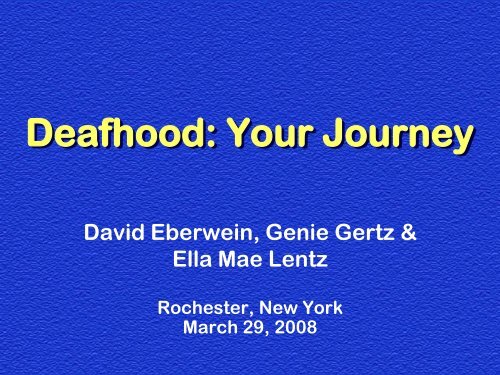

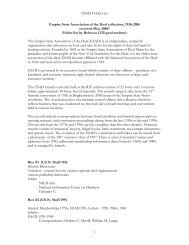

![A Conversation with Danny Glover & Joslyn Barnes [PDF]](https://img.yumpu.com/17810254/1/190x245/a-conversation-with-danny-glover-joslyn-barnes-pdf.jpg?quality=85)

